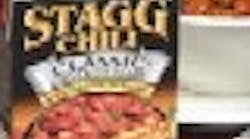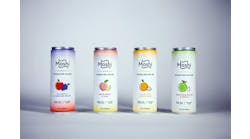Strongly flavored, pungent chili and meat dishes have been around since the time of the Incas and may have been brought to the U.S. by settlers from the Canary Islands. The true popularization of this food came from the cattle drives of the old West where the trail cooks had to cover the flavor of either fresh killed, unaged or potentially spoiled older beef with fat, pepper, salt and chili peppers.The strongly spiced meat and vegetable mixture may have been one of the original fast foods, with places like Chili Queens selling the fare in the Haymarket plaza of San Antonio for many years. There was even a San Antonio Chili stand at the Chicago World's Fair in 1893. By the Depression years, there was hardly a town that didn't have a chili parlor, even if it was nothing more than a hole-in-the-wall place with half a dozen bar stools in front of the linoleum-topped counter.If you are dealing with a classic like chili and you have made many different types (hot, really hot, low fat, turkey), what is your next innovation? Hormel’s answer is to put chili in a box, actually a retortable multi-layer carton. The Tetra Pak Recart offers this new twist on the chili can. Its materials and shape offer efficiency gains throughout the distribution and post-distribution chains. Does this make a difference to the consumer?Understanding the marketplaceStrongly flavored foods have been on the rise for years. The $3.9 billion packaged soup market of which chili is a part, increased 10.9 percent between 1998 and 2003, according to Mintel International. But, after adjusting for inflation, that means the category actually declined 1.6 percent in constant dollars. Soups and stews are thin-margin markets, and operational efficiencies can make a difference between profit and loss for a manufacturer.For the consumer, busy households and fewer cooking skills have equated to less interest in spending time over meal preparation: 60 percent of consumers 18-34 years old said they didn't have the time for all the fuss, and so did 33 percent those more than 55. Similarly, 56 percent of households with annual income exceeding $50,000 a year said they were too busy for long-form meal preparation versus 41 percent of households making less than $25,000 a year, according to AC Nielsen research in 2003. If the consumer has multiple brands of a similar product available, will the ease of use and storage of one product’s packaging be enough to win over consumers?Stagg Chili is a beloved West Coast brand. Through significant marketing and product development efforts in the early 1990s, it produced significant growth in its regional markets and got the attention of other chili manufacturers. Many regional chili makers (like Wolf and Dennison’s) had loyal followings but had been bought in the acquisitions of the 1970s and '80s.However, Stagg remained independent…but also relatively small. Then Hormel Foods Corp. purchased Stagg in 1996. It was a good match: familiar, standard Hormel chili complemented by a different formulation and a new name in many markets.Meanwhile, Tetra Pak had been trying to break into the “particulate” packaged market for a long time. The Tetra Pak Recart packaging offers several benefits over metal cans. These include less packaging to deliver the same amount of chili, less waste, less space and better stacking, packaging material from a renewable resource and ease of use. But ... it is different.So this is an interesting marriage: a well formulated though less broadly recognized food brand, which is looking for something that will help it get noticed, meets a nice packaging company looking for the right opportunity to launch a retorted box in the U.S. market. Hormel, which has never been afraid of innovation, can try a novel package that has manufacturing, materials, distribution and other implications and just might change the whole landscape of “canned” foods.Observation: Consumers are seeking comforting cravable foods but, as with all cravable foods, they must be available whenever the consumers want them.Packaging provides an opportunity for consumers to provision these cravable foods in their pantry more easily. And this package can be opened even when no can opener is around. If the packaging makes the food more easy to use, then the craving is more easily fulfilled.InsightsOur Crave It!, Healthy You!, and It!s Convenient studies integrated 30 conjoint studies to generate a database that can be used to understand the experience of foods in the marketplace – including the brand, health benefits, secondary aspects, emotions and benefits. To be healthy, bean-based products and soups are about being thick and chunky, with lots of vegetables, classic flavors, and a good source of fiber, with plump beans that have either a light texture or meaty texture. Beans and soups/stews that are convenient are about being made the old-fashioned way, thick and chunky like a meal, classic flavors, and a hearty combination of beans and meat. Not making a mess while eating is also important for a convenience food.The key attributes for beans or soups perceived to be healthy are taste, price, amount of fat and brand. The key attributes for beans or soups perceived as convenient are taste, aroma, appearance and price.Key trends in stews (like chili) and soups are value, taste and healthiness. Convenience is an expected norm.Value: Private label or store brand items have improved their delivery of quality and sensory attributes to foods. This leads to an expectation that store brands are good enough, driving manufactured brands to even higher levels of innovation and delivery to justify the price difference.Taste: Flavorful menu items and ethnic flavors have been the strongest drivers of sales. The focus on Asian, Mexican and other Hispanic flavors via the additions of flavorings like cheeses, spicy seasonings and the addition of unique vegetables and beans are the key drivers. Stagg was able to capitalize on these trends in the early 1990s.Healthiness: Chilis, stews and soups have focused on reducing the fat and calories and in some cases the number of ingredients in their offerings. There has not been a strong focus on providing healthiness via addition of “functional” ingredients.Convenience: This is expected. In packaging, this includes both storage, ease of opening, ease of cooking and ease of clean up, along with any other additional ways of helping consumers prepare or consuming their foods. Campbell Soup has been the key driver in the marketplace with its Soup at Hand options, easy-open lids and other functional packages. Other manufactures have had to play catch-up to Campbell.The experienceStagg Chili is available in 12 flavor varieties including Classic, Silverado, Country, Turkey Ranchero and Vegetable Garden at $1.89 per can (or box). The package is a brick pack with “easy open” and “easy pour” marked on the package top. The flavor type is included in a ribbon on the front of the package along with yet another ribbon featuring “Smart Pak – Preservative Free.”For many consumers, the current pop-open, easy-open cans are not easy to open. They require a good level of grip strength and leveraging of the can. Some people report they have had to turn the can upside down and use a can opener to get the package open. As chili is a provisioned stored food, the need to be able to conveniently store the container then easily open it is critical. Smart Pak is a small profile box that stacks easily in the cupboard and is recyclable. For neat freaks or people with little storage space, these boxes line up well and create more space on a shelf.When we first looked at the package, it scared us. We had no idea how to open this new “can.” The chili package opens by lifting the tabs, squeezing, tearing and pouring into a container for preparation. Lifting the tabs requires an ability to mechanically leverage the tabs up; if not done with the fingers, it can be done with a cooking implement.Since the container was perforated, tearing was easier than expected. A scissors could be used if necessary. The seniors in our testing groups were pleasantly surprised (they tend to have issues with other forms of packaging). The tear allows the consumer to control the size of the opening, which also controls the amount of mess when pouring. Moms thought this “brick” would be good for children, but hoped the kids would not get lazy and try to throw the Smart Pak in the microwave. That is a no-no, as this has a metal layer.Remember the fat on the top of the can when you open chili? None here. The manufacturing must have allowed good mixing of whatever free fat was around. The chili is rich but mildly flavored with the general flavor of tomato and chunky pieces of ground meat. The flavors of green bell peppers and onions do not stand out but mix well with the overall chili. The kidney beans are hearty.Upon tearing the package, the aroma of chili begins to fill the room. One of our tasters from the West Coast was familiar with Stagg Chili and felt the product was unchanged by the processing in this new package. The chili has a “rich” quality and is spicy yet blended. The dark reddish color of Silverado says chili. The meatiness is distinctive; you know you are eating food, not a snack. The chili we evaluated had two kinds of beans. The combination of tender but chewable beans and tender meat was very satisfying.Stagg’s ingredient statement reads tomatoes, beef, water, beans and other ingredients. It has 250 calories per serving with 60 of those coming from fat. Protein is 17 g. Sodium is a hefty 790 mg (33 percent of the daily recommended amount). Stagg compares well to Campbell’s Chunky Beef Chili, which has 220 calories per serving, 13 g of protein and 880 mg of sodium. Bush Brothers’ ”Best Homestyle Chili” has 250 calories per serving with 90 of those coming from fat, 14 g of protein and 1,260 mg of sodium.Does the product deliver?This brand claims to be “the Chili lover’s Chili. It is a chili so loaded with good things, it has taste you actually can see.” The product supports the idea of being loaded with good things that you can see. The meat chucks were large and plentiful, the beans are large, but the green peppers and onions are difficult to spot. The color tells us chili powder is being used.Does the new package add or subtract? It does make the product easier to store, to open and to prepare. While the package does nothing to make us feel better about the environment, that may come in time. This was a good product and the package did not change that experience very much at all when we got beyond the initial differences.How to make the idea biggerWhile the product delivers on the promise, there are some opportunities to make this one even bigger.Further health benefits that could improve the product are less about the fat content and more about enhancing the amount of fiber. Nutritionists are looking for us to eat more fiber. Stagg Chili has 6 g of fiber. Bush Brothers chili has 8 g of fiber. Beans are an excellent source of protein and fiber, so this is a message that could be expanded and developed.Tetra Pak delivers on the new package technology. Hormel has an opportunity to understand this package in real market situations. This is probably the beginning of a real shift in certain packaged foods.Rating: The product and package together deliver on the promises.Market Potential: Good for the package, good for Hormel. The package is easy to store and open. The product has stayed the same, so if this allows more distribution or consumer interest, it might grow Stagg market share. The operational efficiencies of this package should make this a more profitable option for Hormel. We will see more complex foods in this package in the future.

Latest from New Food Products
Latest from New Food Products

